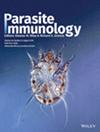Fungal pathogens: The underappreciated parasites that are now in the spotlight.
IF 1.4
4区 医学
Q4 IMMUNOLOGY
引用次数: 0
Abstract
Fungi pose a significant threat to human health by causing a complex array of different diseases. These include superficial but potentially disfiguring infections, chronic allergic disorders and systemic lifethreatening fungal diseases, all of which have been estimated to affect over a billion people worldwide. Despite the significant threats that fungi pose, they are frequently overlooked and fungal-mediated deaths are under reported. There is an urgent need to improve our ability to diagnose fungal infections and develop improved therapeutics to combat these challenges. However, a significant challenge which has greatly impeded this progress is the mechanistic understanding of the fungal–host interactions which underpin disease. For this special issue in Parasite Immunology, a series of reviews explore the latest development within the field of fungal immunology by focusing on the role of the fungi as a pathogen versus commensal, the host immune response, emerging fungi species of concern and how these infections are treated. Each review also identifies key challenges and future opportunities which may achieve the goal of reducing the threat that fungi pose to human health. To understand anti-fungal defence, it is vital to reflect that we are constantly under threat from fungal infection and whether fungi are cleared, become commensals, or invade the tissue is the outcome of dynamic host–fungus interaction. Brown considers this and highlights how pathogenicity traits that promote infection have emerged independently across distinct phylogenetic branches of fungi allowing them to occupy different niches within the host. This review proposes the “Resilience Network” concept as a framework in which to understand how fungal pathogens can exhibit extraordinary diversity in their physiological robustness which underpins their immune evasion and drug resistance capability. Exciting future research goals are proposed to unravel this network with the tantalizing prospect that this will dramatically improve our therapeutic capability to combat fungal disease. Over the last 20 years, it has become apparent that commensals are a vital component in mediating human health and disease. Yet, the vast majority of research into this has focused on bacterial species despite the fact that the fungi are a major constituent of our commensal community (termed the “mycobiome”). Ruchti and LeibundGut– Landmann focus on evaluating what is known about the role of fungi as an integral part of the skin microbiota. They discuss how these fungi have the potential to trigger and exacerbate skin diseases, and the importance of host IL-17 cytokine mediated responses in the skin at combatting these infections. They also consider the impact of a newly emerged drug-resistant fungal species that colonizes the skin (Candida auris). However, much remains unknown about fungi–host interaction in the skin and the authors suggest how recent technological advances have the potential to expand our understanding of this interaction to benefit future treatment. Immune cell recognition of fungi is vital for the host to mount a successful anti-fungal response. One class of pathogen recognition receptors expressed on immune cells, the C-type lectin receptors (CLRs), play an essential role in recognizing components of the fungal outer cell wall. Hatinguais et al. evaluate the complex array of different CLR family members and evaluate their role in mediating antifungal immunity. This can involve collaboration with other classes of ligand (e.g. toll-like receptors). Furthermore, CLRs can also recognize numerous endogenous ligands in the host and can greatly impact anti-fungal immunity. The authors highlight that our understanding of these interactions is still in its infancy and make insightful observations of how these will impact on what directs fungal infection vs commensalism. People living on the African continent are particularly vulnerable to deadly fungal infection. Opportunistic fungal pathogens can exploit the disproportionally high burden of human immunodeficiency virus infections, lack of high-quality health care and unavailability of antifungal drugs. Dangarembizi et al. focus on two fungi, Cryptococcus and Pneumocystis, that cause high morbidity and mortality in Africa. Strikingly, they further highlight the emerging fungal pathogens of concern including dimorphic fungi such as Histoplasma and Emergomyces spp. Current epidemiology, pathogenesis and treatment strategies are evaluated along with how socioeconomic development and the ongoing COVID-19 pandemic may impact the emergence of new fungal diseases in the future. Fungi are eukaryotic pathogens, capable of morphotype switching and adapting to their niches within the host. Therefore, this poses a significant challenge in developing effective therapeutics that can treat fungal infection. Armstrong–James focuses on current antifungal chemotherapies and provides an overview of the limited approaches that are currently employed in patients (only three major drug classes). Furthermore, an overview is provided of the current anti-fungal drugs in the pipeline. The role of immunotherapy in treating fungal infections is an exciting development, and the review provides a summary of strategies that are in the pipeline and what could possibly emerge in the future. Taken together, this series of reviews reflects the exciting developments and challenges that need to be tackled to understand the fungal threat. As highlighted throughout the reviews, the mechanisms by which fungal pathogens have evolved to colonize and infection the Accepted: 11 January 2023真菌病原体:不被重视的寄生虫,现在在聚光灯下。
本文章由计算机程序翻译,如有差异,请以英文原文为准。
求助全文
约1分钟内获得全文
求助全文
来源期刊

Parasite Immunology
医学-寄生虫学
CiteScore
4.70
自引率
4.50%
发文量
61
审稿时长
6-12 weeks
期刊介绍:
Parasite Immunology is an international journal devoted to research on all aspects of parasite immunology in human and animal hosts. Emphasis has been placed on how hosts control parasites, and the immunopathological reactions which take place in the course of parasitic infections. The Journal welcomes original work on all parasites, particularly human parasitology, helminths, protozoa and ectoparasites.
 求助内容:
求助内容: 应助结果提醒方式:
应助结果提醒方式:


